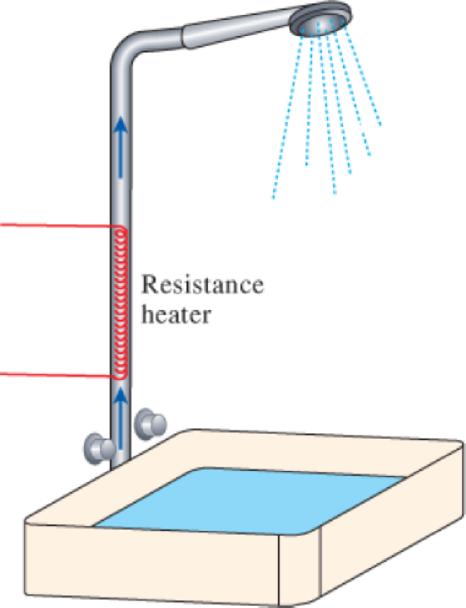
Concept explainers
- (a) Water flows through a shower head steadily at a rate of 10 L/min. An electric resistance heater placed in the water pipe heats the water from 16 to 43°C. Taking the density of water to be 1 kg/L, determine the electric power input to the heater in kW and the rate of entropy generation during this process in kW/K.
FIGURE P7–209

- (b) In an effort to conserve energy, it is proposed to pass the drained warm water at a temperature of 39°C through a heat exchanger to preheat the incoming cold water. If the heat exchanger has an effectiveness of 0.50 (that is, it recovers only half of the energy that can possibly be transferred from the drained water to incoming cold water), determine the electric power input required in this case and the reduction in the rate of entropy generation in the resistance heating section.
a)
The electric power input to the heater and the rate of entropy generation during the process.
Answer to Problem 209RP
The electric power input to the heater is
The rate of entropy generation during the process is
Explanation of Solution
Write the expression for the energy balance of steady flow system.
Here, rate of net energy transfer in to the control volume is
Write the expression to calculate the mass flow rate
Here, density of water at room temperature is
Write the expression for the entropy balance equation of the system for steady flow process.
Here, rate of net entropy in is
Conclusion:
There is only one exit and one inlet, write the equation for the mass balance of steady flow system as,
Here, mass flow rate of water at inlet is
The rate of change in internal energy of system inside the system is zero at steady state,
Substitute 0 for
Here, electric power input to the heater is
From Table A-3 “Properties of common liquids, solids and foods”, the value for the density
Substitute
Substitute
Thus, the electric power input to the heater is
Substitute
Since, water is incompressible substance,
Here, rate of entropy generation at stage 1 is
Substitute
Thus, the rate of entropy generation during the process is
b)
The electric power input required and the reduction in the rate of entropy generation in the resistance heating section.
Answer to Problem 209RP
The electric power input required is
The reduction in the rate of entropy generation in the resistance heating section is
Explanation of Solution
Write the expression to calculate the energy saved
Here, effectiveness of heat exchanger is
Write the expression to calculate the required electric power
Here, electric power input to the heater is
Write the expression to calculate the temperature at which the cold water leaves heat exchanger.
Here, the energy saved is
Write the expression to calulate the entropy generation at stage 2.
Here, rate of entropy generation at stage 2 is
Write the expression to calculate the reduction in the rate of entropy generation within the heating section
Here, reduction in the rate of entropy generation is
Conclusion:
Substitute 0.5 for
Substitute
Substitute
Substitute
Substitute
Thus, the reduction in the rate of entropy generation in the resistance heating section is
Want to see more full solutions like this?
Chapter 7 Solutions
Thermodynamics: An Engineering Approach
- (read me)arrow_forward(read image)arrow_forwardQu. 13 What are the indices for the Direction 2 indicated by vector in the following sketch? Qu. 14 Determine the indices for the direction A and B shown in the following cubic unit cell. please show all work step by step from material engineeringarrow_forward
- The thin-walled open cross section shown is transmitting torque 7. The angle of twist ₁ per unit length of each leg can be determined separately using the equation 01 = 3Ti GLIC 3 where G is the shear modulus, ₁ is the angle of twist per unit length, T is torque, and L is the length of the median line. In this case, i = 1, 2, 3, and T; represents the torque in leg i. Assuming that the angle of twist per unit length for each leg is the same, show that T= Lic³ and Tmaz = G01 Cmax Consider a steel section with Tallow = 12.40 kpsi. C1 2 mm L1 20 mm C2 3 mm L2 30 mm C3 2 mm L3 25 mm Determine the torque transmitted by each leg and the torque transmitted by the entire section. The torque transmitted by the first leg is | N-m. The torque transmitted by the second leg is N-m. The torque transmitted by the third leg is N-m. The torque transmitted by the entire section is N-m.arrow_forwardPlease help, make sure it's to box out and make it clear what answers go where...arrow_forwardThe cylinder floats in the water and oil to the level shown. Determine the weight of the cylinder. (rho)o=910 kg/m^3arrow_forward
 Elements Of ElectromagneticsMechanical EngineeringISBN:9780190698614Author:Sadiku, Matthew N. O.Publisher:Oxford University Press
Elements Of ElectromagneticsMechanical EngineeringISBN:9780190698614Author:Sadiku, Matthew N. O.Publisher:Oxford University Press Mechanics of Materials (10th Edition)Mechanical EngineeringISBN:9780134319650Author:Russell C. HibbelerPublisher:PEARSON
Mechanics of Materials (10th Edition)Mechanical EngineeringISBN:9780134319650Author:Russell C. HibbelerPublisher:PEARSON Thermodynamics: An Engineering ApproachMechanical EngineeringISBN:9781259822674Author:Yunus A. Cengel Dr., Michael A. BolesPublisher:McGraw-Hill Education
Thermodynamics: An Engineering ApproachMechanical EngineeringISBN:9781259822674Author:Yunus A. Cengel Dr., Michael A. BolesPublisher:McGraw-Hill Education Control Systems EngineeringMechanical EngineeringISBN:9781118170519Author:Norman S. NisePublisher:WILEY
Control Systems EngineeringMechanical EngineeringISBN:9781118170519Author:Norman S. NisePublisher:WILEY Mechanics of Materials (MindTap Course List)Mechanical EngineeringISBN:9781337093347Author:Barry J. Goodno, James M. GerePublisher:Cengage Learning
Mechanics of Materials (MindTap Course List)Mechanical EngineeringISBN:9781337093347Author:Barry J. Goodno, James M. GerePublisher:Cengage Learning Engineering Mechanics: StaticsMechanical EngineeringISBN:9781118807330Author:James L. Meriam, L. G. Kraige, J. N. BoltonPublisher:WILEY
Engineering Mechanics: StaticsMechanical EngineeringISBN:9781118807330Author:James L. Meriam, L. G. Kraige, J. N. BoltonPublisher:WILEY





